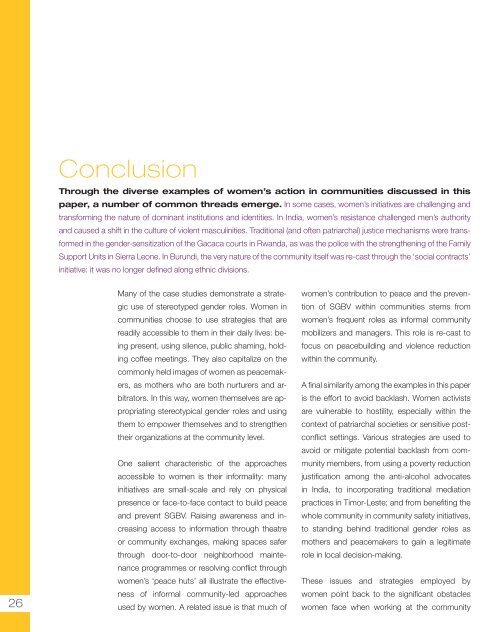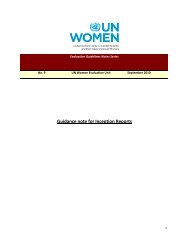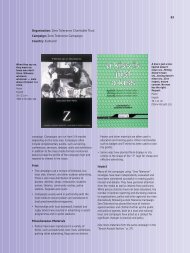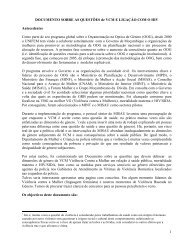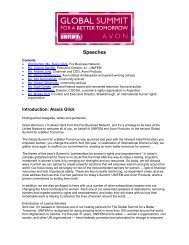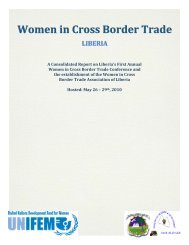W omen Building Peace and Preventing Sexual Violence - UN Women
W omen Building Peace and Preventing Sexual Violence - UN Women
W omen Building Peace and Preventing Sexual Violence - UN Women
You also want an ePaper? Increase the reach of your titles
YUMPU automatically turns print PDFs into web optimized ePapers that Google loves.
26<br />
Conclusion<br />
Through the diverse examples of w<strong>omen</strong>’s action in communities discussed in this<br />
paper, a number of common threads emerge. In some cases, w<strong>omen</strong>’s initiatives are challenging <strong>and</strong><br />
transforming the nature of dominant institutions <strong>and</strong> identities. In India, w<strong>omen</strong>’s resistance challenged men’s authority<br />
<strong>and</strong> caused a shift in the culture of violent masculinities. Traditional (<strong>and</strong> often patriarchal) justice mechanisms were transformed<br />
in the gender-sensitization of the Gacaca courts in Rw<strong>and</strong>a, as was the police with the strengthening of the Family<br />
Support Units in Sierra Leone. In Burundi, the very nature of the community itself was re-cast through the ‘social contracts’<br />
initiative: it was no longer defined along ethnic divisions.<br />
Many of the case studies demonstrate a strategic<br />
use of stereotyped gender roles. W<strong>omen</strong> in<br />
communities choose to use strategies that are<br />
readily accessible to them in their daily lives: being<br />
present, using silence, public shaming, holding<br />
coffee meetings. They also capitalize on the<br />
commonly held images of w<strong>omen</strong> as peacemakers,<br />
as mothers who are both nurturers <strong>and</strong> arbitrators.<br />
In this way, w<strong>omen</strong> themselves are appropriating<br />
stereotypical gender roles <strong>and</strong> using<br />
them to empower themselves <strong>and</strong> to strengthen<br />
their organizations at the community level.<br />
One salient characteristic of the approaches<br />
accessible to w<strong>omen</strong> is their informality: many<br />
initiatives are small-scale <strong>and</strong> rely on physical<br />
presence or face-to-face contact to build peace<br />
<strong>and</strong> prevent SGBV. Raising awareness <strong>and</strong> increasing<br />
access to information through theatre<br />
or community exchanges, making spaces safer<br />
through door-to-door neighborhood maintenance<br />
programmes or resolving conflict through<br />
w<strong>omen</strong>’s ‘peace huts’ all illustrate the effectiveness<br />
of informal community-led approaches<br />
used by w<strong>omen</strong>. A related issue is that much of<br />
w<strong>omen</strong>’s contribution to peace <strong>and</strong> the prevention<br />
of SGBV within communities stems from<br />
w<strong>omen</strong>’s frequent roles as informal community<br />
mobilizers <strong>and</strong> managers. This role is re-cast to<br />
focus on peacebuilding <strong>and</strong> violence reduction<br />
within the community.<br />
A final similarity among the examples in this paper<br />
is the effort to avoid backlash. W<strong>omen</strong> activists<br />
are vulnerable to hostility, especially within the<br />
context of patriarchal societies or sensitive postconflict<br />
settings. Various strategies are used to<br />
avoid or mitigate potential backlash from community<br />
members, from using a poverty reduction<br />
justification among the anti-alcohol advocates<br />
in India, to incorporating traditional mediation<br />
practices in Timor-Leste; <strong>and</strong> from benefiting the<br />
whole community in community safety initiatives,<br />
to st<strong>and</strong>ing behind traditional gender roles as<br />
mothers <strong>and</strong> peacemakers to gain a legitimate<br />
role in local decision-making.<br />
These issues <strong>and</strong> strategies employed by<br />
w<strong>omen</strong> point back to the significant obstacles<br />
w<strong>omen</strong> face when working at the community


